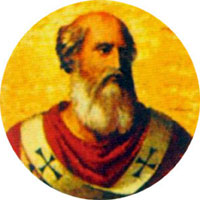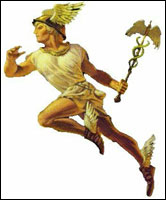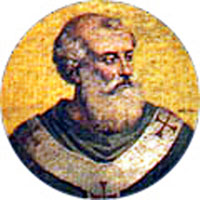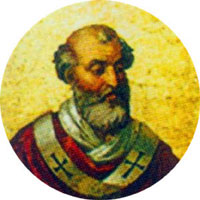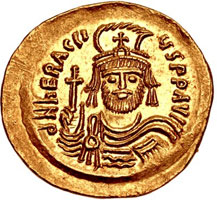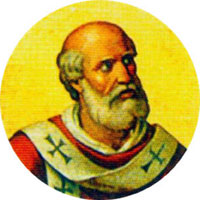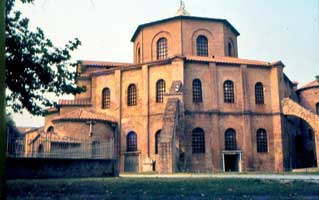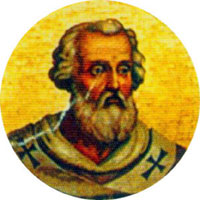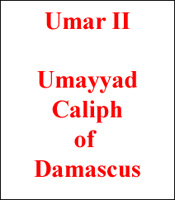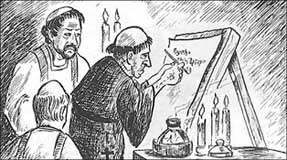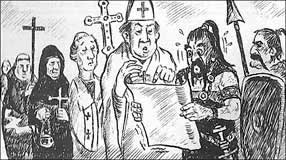In the English language, JOHANAN is transliterated as JOHN, Ioannes in Latin, Giovanni in Italian, Jean in French, and Juan in Spanish.
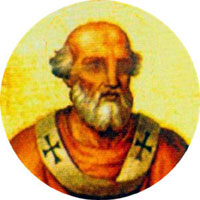 Pope John I. Pope from 523 to 526. |
|
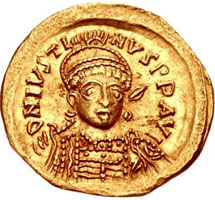 Justin I (450–527). Reigned from 518 to 527. |
His real intent was to obtain the help of Justin I in suppressing the Ostrogoths.
The Ostrogoths—under Theodoric the Great—were genuine Christians who wanted nothing to do with the Papacy. That is why they were called ARIANS, and Pope John needed the cooperation of Justin I in suppressing them. Soon after his return from Constantinople, Theodoric imprisoned Pope John, and he went to St. Peter shortly thereafter.
|
|
|
Mercury is shown holding a caduceus, which was originally a magic wand awarded to him by Apollyon. The Pope's staff or rod was adopted from the caduceus!
Just 6 years after his reign ended, the Plague of Justinian devastated Eastern Europe and North Africa, resulting in the deaths of 25 to 50 million people!
|
|
|
Byzantine Emperor Constantine IV led the heroic defense of the city. The Arabs were confronted by a secret weapon called Greek Fire. It was somewhat like napalm and actually burned on the water. It was the ancient world's equivalent of the atomic bomb.
Another milestone during his reign was the death of Byzantine Emperor Justinian in 565. Justinian played a pivotal role in the history of the Papacy during his long reign.
|
|
|
By changing the official language from Latin to Greek, Emperor Heraclius drove a wedge between Roma and Constantinople that still continues to this day. Furthermore, Constantinople was located in an area that was formally part of the Greek or Third Universal Empire.
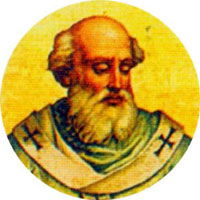 Pope John V. Pope from 685 to 686. |
|
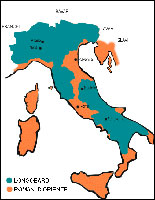 The Exarchate of Ravenna from 584 to 751. |
By 686, dissension was growing between Roma and Constantinople over language, images, appointment of Popes, the nature of Christ, etc., etc. The 2 cities were not on the same page at all concerning vital theological issues.
|
|
|
Pagan Roma withdrew from Britannia in 410, but in 704, Pope John VI received an embassy from that island named Wilfrid of York. Wilfrid was sent back to Britannia with order for King Æthelred of Mercia to implement Papal "reforms." Foremost on his agenda was the suppression of the Celtic date for Passover-Resurrection.
|
|
|
In 755, a miraculous event happened when Pope Stephen II received an airmail letter from St. Peter up in heaven. The missive demanded that King Pepin of the Franks deliver Roma from the Lombards.
|
The year 755 marks the official begriming of the Papal States and the Popes began to wear the Triple Crown in commemoration of that event.
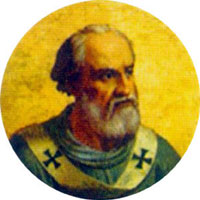 Pope John VIII. Pope from 872 to 882. |
|
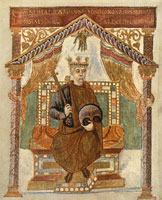 Charles the Bald (823–877). Ruled from 875 to 877. |
The area King Charles ruled over was neither Roman nor holy. All of the king that followed Charlemagne were crowned by the Popes.
By being crowned by Pope Leo III, Charlemagne set a precedent that was followed by all the other kings of the fake "Holy Roman Empire" dynasty.
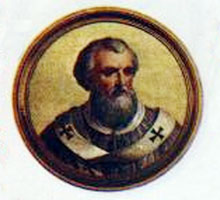 Pope John IX Pope from 899 to 900. |
|
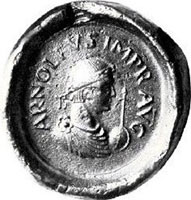 The seal of Arnulf of Carinthia. Fake "Roman Emperor" from 881 to 899. |
In 896, Arnulf suffered a stroke and could no longer rule his fake "Roman Empire." He died in December 899 and Pope John IX followed him the following year.
Pope Joan VII was removed from the list of canonical Popes!
The name Joan is the female transliteration of John, Giovanna in Italian, and Juana in Spanish. In the list of Pope Johns there is no Pope Pope John XX due to the fact that Pope Joan was eliminated from the list.
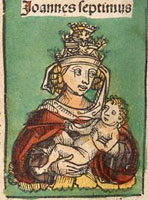 Pope Joan VII. Reigned from 855 to 857. |
|
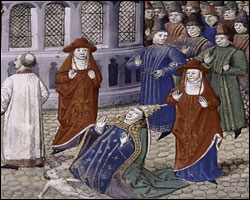 Medieval artistic rendition of Pope Joan giving birth. |
Saint Martin Luther, in his Table Talk, states that he saw a commemorative statue of Pope Joan when he visited Roma in 1510:
In Rome, in a public square, there is a stone monument to commemorate the pope who was really a woman and gave birth to a child on that very spot. I have seen the stone myself, and I find it astonishing that the popes permit it to exist. (Luther, Table Talk, p.133).
When Saint Martin was excommunicated by Pope Leo X, he began an intensive study of the Book of Daniel and the Apocalypse of Saint John. It was from a study of those 2 books that led him to write his magnum opus entitled On the Babylonian Captivity of the Church.
Vital links
References
Luther, Saint Martin. Table Talk. William Du-gard, London, 1652.
Norwich, John Julius. Absolute Monarchs: A History of the Papacy. Random House, New York, 2011.
Rappaport, Angelo S. The Love Affairs of the Vatican. Barnes & Nobles Books, New York, 1995. (Originally published in 1912).
Woodrow, Ralph. Babylon Mystery Religion Ancient and Modern. Ralph Woodrow Evangelistic Association. Riverside, CA., 1966.
